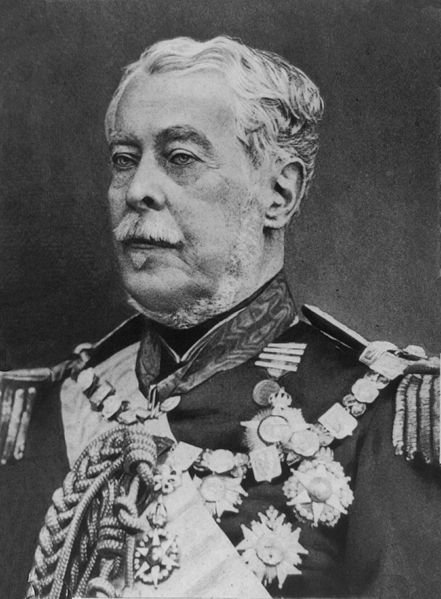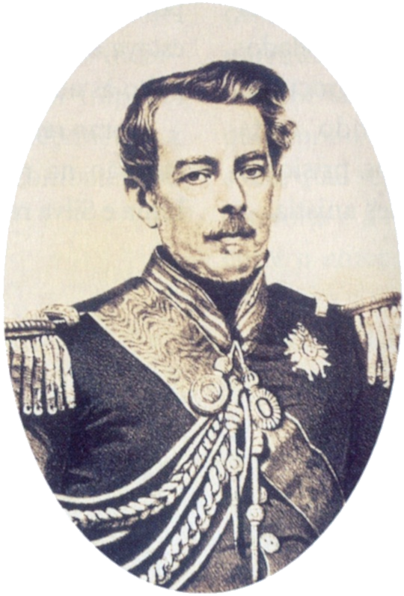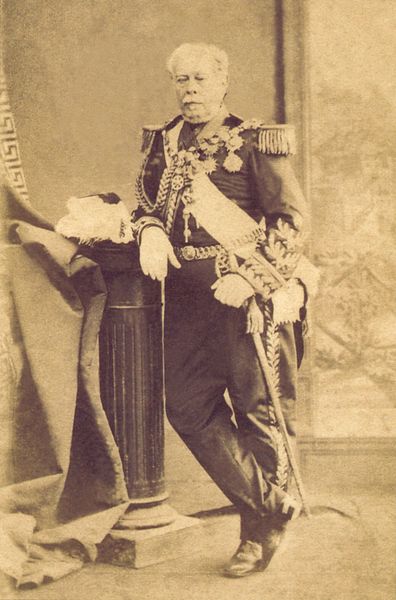<Back to Index>
- Physician Emil Theodor Kocher, 1841
- Writer Francis Bret Harte, 1836
- Prime Minister of the Brazilian Empire Luís Alves de Lima e Silva, Duke of Caxias, 1803
PAGE SPONSOR



Luís Alves de Lima e Silva, Duke of Caxias (August 25, 1803 – May 7, 1880) was a Brazilian military leader and statesman. He was a leader of the Conservative Party and on more than one occasion served as Prime Minister of the Brazilian Empire. Considered one of the most important heroes in Brazilian military history, Caxias fought in the Argentina - Brazil War, the War of Tatters, Platine War, and, most notably, in the War of Triple Alliance. He was the only Brazilian not related to the House of Braganza to receive the honorary title of Duke (the others being Auguste de Beauharnais, Duke of Santa Cruz and the Duchesses of Goiás and Ceará, illegitimate daughters of Emperor Pedro I), and the only Duke to be created in the reign of Emperor Pedro II.
Caxias entered the military while in adolescence, and rapidly rose to the ranks of General and Baron, subsequently becoming Marshal, Count, Marquis, Senator, and Aide-de-Camp to the Emperor. He was twice Minister of War and
also President of the Council, exerting great political influence as a
conservative leader. Caxias was superseded as commander of the
Brazilian Forces by the Count d'Eu after the capture of Asunción, and received the title of Duke in 1869. The Brazilian holiday Dia do Soldado (Portuguese, "Soldiers Day"), celebrated on his birthday, August 25, and the cities of Duque de Caxias and Caxias do Sul are named in his honor. He is honoured as the Patron of the Brazilian Army. Luís Alves de Lima e Silva was born on 25 August 1803, in a plantation located in Porto da Estrela, nowadays located in the Parque Histórico Duque de Caxias, in the state of Rio de Janeiro. He was the son of Marshal Francisco de Lima e Silva, 1st Baron of Barra Grande (older brother of José Joaquim de Lima e Silva, 1st Viscount of Magé and older brother and father in law of Manuel da Fonseca de Lima e Silva, 1st Baron of Suruí), and wife Dona Mariana Cândida de Oliveira Belo, an official in the court of Empress Leopoldina, who later had the honor of presenting the infant Dom Pedro II to the Brazilian royal court. Little is known of Caxias' childhood. The almanacs of contemporary Rio de Janeiro name his father's dwelling place as Rua das Violas, currently named Rua Teófilo Otoni. On this street, violin and guitar (violas) makers would unite with musicians and composers, and greatly marked the development of Caxias' childhood. It
is also known that he studied in the Convento de São Joaquim,
which is presently located in the Colégio Dom Pedro II. In 1818, at 15 years of age, he enrolled at the Academia Real Militar ("Royal Military Academy"), where he was eventually promoted to a Lieutenant, and, in 1821, served in the first artillery battalion, an elite unit of the imperial army. The return of the royal family eventually resulted in the establishment of the Brazilian Empire. After Dom Pedro I proclaimed the independence, he organized an Imperial Guarda de Honra e o Batalhão do Imperador —
an Imperial guard formed by eighty military soldiers, considered to be
the elite in athletic and tactical skills. Caxias' father received the
newly created flag of the Empire from the hands of the Emperor himself,
on 10 November 1822, at the imperial chapel. On 3 June 1823, the young soldier saw his first military action, when the Emperor's Battalion was sent to Bahia, to crush a pacifist movement against Brazil's independence led by General Madeira de Melo. After returning from this campaign, he received the most prized title of his life as Veterano da Independência — veteran of independence. In 1825, he participated in the Argentina - Brazil War, where he fought in the Pampas region with the Emperor's battalion. His bravery and competence as a commander eventually lead to promotion as a Major. On January 6, 1833 in Rio de Janeiro,
he married the sixteen year old Ana Luísa do Loreto Fernandes
Carneiro Viana (December 30, 1816 – March 23, 1874), whose brother,
Paulo Fernandes Carneiro Viana, was later created 1st Baron and 1st
Count of São Simão, and whose sister Maria Leonor
Fernandes Carneiro Viana, married Dom Francisco da Costa de Sousa de
Macedo, 1st Viscount and 1st Marquis of Cunha. In 1837, he was promoted to the rank of Lieutenant Colonel, and was chosen for "his administrative skills and disciplined spirit," as he pacified a revolt in the Maranhão region, which became known as the Balaiada. On 2 December 1839, he was promoted to Colonel, and by an Imperial Charter, nominated as president of Maranhão, and general commander of the military, with the responsibility of taming the post-revolutionary civilians under one rule. In 1841, Caxias was promoted to the position of a Brigadier General,
unanimously invested with the Arms of the Court, and later given the
tile of Baron of Caxias, mostly for his efficacy in subjugating the
conflict in Maranhão. In May 1842, following an uprising known as the War of Tatters from
the Southern states by the Liberal Party, Dom Pedro II called on Caxias
to pacify the region. He was later named commander in chief of
operational forces, and vice president of the state. After having
accomplished several feats in the mission after a little over a month,
the government, fearing a rebellion in Minas Gerais, diverted his activities there nominating him to restore peace to that region — which he did by the beginning of September. On
30 July 1842, he was given a field commission as Marshal because of his
"relevant services in the provinces of São Paulo and Minas
Gerais", although he had not reached the age of 40. Also that year, he
was given a title as commander in chief of the Army, and the presidency
of the province of Rio Grande do Sul. The War of the Tatters still
lingered in the south. More than six presidents of the province and
generals had commanded the counter revolutionary forces unsuccessfully.
Thus, he was given operational command of the Rio Grande do Sul state. Caxias is remembered for his humility after capturing 10 commanders of the revolutionary forces at Santa Luzia, eventually freeing them. On 1 March 1845, the War of Tatters ended, and Caxias was given the title Marechal Barão de Caxias ("Baron-Marshal of Caxias"), later being promoted to Count. He was also proclaimed the "Pacifier of Brazil" and assumed a the role of a senator in the Rio Grande do Sul province. In the year 1851, he was made the commander of the Exército do Sul ("Southern
Army"), and prepared to quell an uprising of gauchos in the southern
frontiers of Brazil. After negotiating with the Uruguayan president, Manuel Oribe, he was able to lower the tensions around the border. In 1852, he was declared a Lieutenant General and Marquis. By 1862, he was made marechal-do-exército — "Marshal of the Army", and resumed the senatorship in 1863. In 1864, the ambitions of the Paraguayan president, Francisco Solano Lopez culminated in the War of Triple Alliance,
in which Brazil, Argentina and Uruguay aligned themselves against
landlocked Paraguay. Caxias was nominated commander in chief of
Imperial forces, in 1866, and was, effectively, marechal-do-exército ("Marshal
of the Army"). One notable fact is that Caxias utilized air
reconnaissance, as he chartered air balloons to monitor military
operations on either side of combat. The
military career of Caxias reached its apex in the battles of the
campaign. For example, his creating roads in the Gran Chaco, allowing
the Brazilian forces to execute a famous march across the Paraguayan
Chaco, which has been immortalized in military literature. His leadership reached levels of excellence, as shown in his
loyalty to his men crossing a stream to fight in the Battle of Itororó, saying "follow me Brazilians!." He captured the capital of Paraguay, Asunción, on 1 January 1869. For his campaigns in Paraguay, he received the title of Duke of Caxias. In 1875, for the third time, he was named the Minister of War and President of the Council of Ministers. Caxias
would still have participatation in other key moments of Brazilian
history but as he was already advanced in age, he retired to his birth
place in the province of Rio de Janeiro, in the Santa Monica ranch. The Duke of Caxias died on 7 May 1880, at 8:30 p.m On
the next day, a train arrived carrying the Duke's body, dressed in a
modest uniform, and bearing only two of his numerous medals — those of General da campanha do Paraguai (General of the Paraguay campaign) and that of Mérito Militar (Military merit). His
final wishes were thus fulfilled after his death, including his wish
for a simple funeral, his coffin carried by soldiers from his unit, and
his body not being embalmed. At the burial, the literary magnate, the Viscount of Taunay, who had been a major in the Army, said: On 25 August 1923, Caxias' birthday was declared Dia do soldado (Soldiers Day), in homage to his military service to the Brazilian Army.
The Army also justified such tribute as he "became one of the greatest
Brazilians of all time, giving his nation over 60 years of exceptional
service as a politician and public administrator… as a soldier of
social peace, and the integrity of the sovereignty of the Brazilian
Empire… Since 1931, the cadets at the Brazilian Military Academy of Agulhas Negras, carry a copy of the Sword of Caxias,
a relic at the Instituto Histórico e Geográfico
Brasileiro. In 1961, he was honored as the "Patron of the Brazilian
Army."